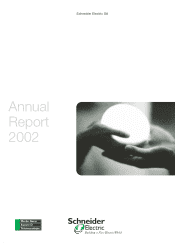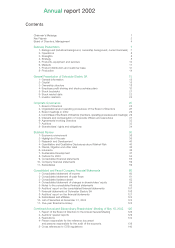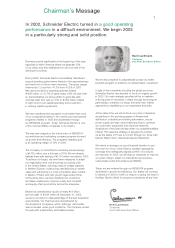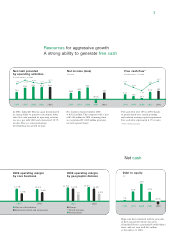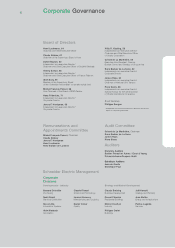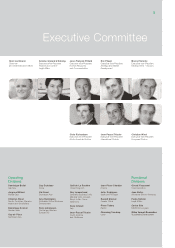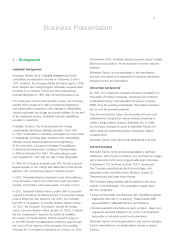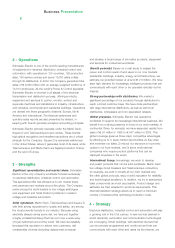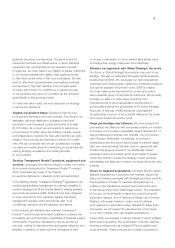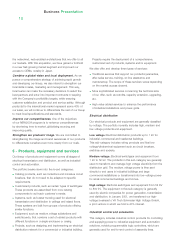APC 2002 Annual Report Download - page 8
Download and view the complete annual report
Please find page 8 of the 2002 APC annual report below. You can navigate through the pages in the report by either clicking on the pages listed below, or by using the keyword search tool below to find specific information within the annual report.
7
Business Presentation
1 - Background
Industrial background
Schneider Electric SA is a Société Anonyme (joint-stock
corporation) incorporated in France on December 2 and 4,
1871. However, the Company traces its history back to 1836,
when Adolphe and Joseph-Eugène Schneider acquired steel
foundries in Le Creusot, France that were experiencing
financial difficulties. In 1838, they formed Schneider & Cie.
From that point until the mid-twentieth century, the Company
steadily built a presence in heavy mechanical engineering
and transportation equipment, with interests in shipbuilding,
railroad equipment and bridge and tunnel building. By the end
of the nineteenth century, Schneider had also established
aposition in electricity.
Gradually, however, the Company grew into a huge
conglomerate that lacked strategic direction. From 1981
to 1997, it refocused on electricity and pulled out of a number
of businesses, including steel, machine tools, shipbuilding,
railways, private telephone systems and engineering.
At the same time, it pursued a strategy of acquisitions
in electricity and automation, bringing in Telemecanique
in 1988 and Square D in 1991. The refocusing process
was completed in 1997 with the sale of Spie Batignolles.
In 1999, the Company acquired Lexel A/S, Europe’s second
largest supplier of low voltage final distribution products and
systems, with operations primarily in Northern Europe.
In 2000, Schneider Electric acquired Crouzet Automatismes,
a French leader in electronic control and small automation
devices, and Positec, a European leader in motion control.
In 2001, Schneider Electric made a public offer to purchase
Legrand in exchange for shares as part of a proposed merger
project. When the offer closed in July 2001, the Company
held 98.1% of Legrand. In an initial decision dated October
10, 2001, the European Commission vetoed the merger,
and in a second decision dated January 30, 2002, it ordered
the two companies to separate as quickly as possible.
As a result, Schneider Electric sold its interest in Legrand
to the KKR-Wendel Investissement consortium even though
the Court of First Instance of the European Communities
overruled the Commission’s decisions on October 22, 2002.
In December 2002, Schneider Electric acquired Japan’s Digital
Electronics Corporation, the world leader in human-machine
interface.
Schneider Electric is now specialized in the manufacture
and sale of products and equipment for electrical distribution,
industrial control and automation.
Ownership background
By 1981, the Company’s ownership structure consisted of a
long chain of holding companies, interlocked via numerous
cross-shareholdings, that separated the parent company,
SPEP, from its operating subsidiaries. This system had been
set up over the preceding decade.
Over the next fourteen years, the ownership structure was
rationalized by merging the various holding companies to
create a single parent company, Schneider SA. In 1999,
the Company changed its name to Schneider Electric SA,
which owns all outstanding shares of Schneider Electric
Industries SAS.
Schneider Electric SAS has foreign subsidiaries of its own.
Current business
Schneider Electric is the worldwide specialist in electrical
distribution, with a focus on medium, low and final low voltage,
and in industrial control and programmable logic controllers.
It operates in 130 countries and has 74,814 employees.
The Company manufactures electrical switchgear and
equipment under the Merlin Gerin, Modicon, Square D,
Telemecanique and Lexel brand names.
The Company enjoys leading global positions in the large
majority of its businesses. The competition breaks down
into two categories:
• Large non-specialist manufacturers with diversified business
bases that offer little or no synergy. These include ABB,
General Electric, Mitsubishi Electric and Siemens.
• Smaller specialist manufacturers, such as Eaton, Hager and
Legrand in electrical distribution and Omron and Rockwell
Automation in industrial control and automation.
Schneider Electric is the largest player in this second category.
It is not dependent on any single patent, license or supply
contract.

